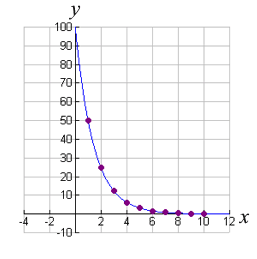LESSON 2: EXPONENTIAL DECAY

What is exponential decay? How is it different from exponential growth? Look at the graph on the left, can you think of any real-life situations that model the graph's behavior? What kinds of things start with a large quantity and "decay" until essentially nothing is left? Check out the introduction video below, then grab your Cornell Notes sheet to use as you watch the presentation for lesson 2.
Introduction
SWBAT
-
Differentiate between exponential growth and decay functions.
-
Identify a function's y-intercept and asymptote (Graph & Non-Graph).
-
Graph an exponential growth function with a TI-84 calculator or smartphone app.
-
Use the compound interest formula to solve real-life situations involving exponential growth.
Absorb
Exponential Decay Presentation
-
Use your Cornell Notes to document important information, processes and/or questions you have.
-
Notes will be checked and scored for content at the beginning of class on February 8. Make sure to have any questions you have written down for clarification.
Do
Practice Problems: 16-24,27-42(Divisible by 3),44-46,50,52 (pg.476)
-
McDougal Littell - Algebra II - Copyright 2004
Take Quiz: Exponential Decay Quick Quiz (5 questions)
Connect
There are only 10,000 pink striped unicorns (just go with it) left in the world. If the population is decreasing at a rate of 25% per year, how many years until the great pink striped unicorn becomes extinct? You can create a function, make a table and/or whatever other method of problem-solving you can conjure up. Happy hunting! (Not the unicorns of course.)
Summary
Exponential decay is decay, upon decay, upon decay. It is characterised by functions with variables in the exponent rather than at the base level. A decay function has a base between 0 and 1. Students should be able to differentiate between growth and decay functions, identify the shape, y-intercept and asymptote of an exponential growth function with and without a graphing calculator. Finally, students should be able to use the compound interest formula to solve real-life situations involving exponential growth.



